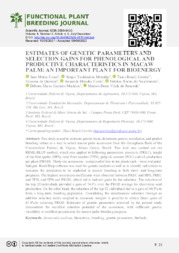Estimates of genetic parameters and selection gains for phenological and productive characteristics in macaw palm: an important plant for bioenergy.
Estimates of genetic parameters and selection gains for phenological and productive characteristics in macaw palm: an important plant for bioenergy.
Author(s): COSER, S. M.; MOTOIKE, S. Y.; CORRÊA, T. R.; QUEIROZ, V. de; COSTA, A. M.; NASCIMENTO, H. R. do; MADEIRA, D. D. C.; RESENDE, M. D. V. de
Summary: This study aimed to estimate genetic traits, determine genetic correlation, and predict breeding values as a way to select macaw palm accessions from the Germplasm Bank of the Universidade Federal de Viçosa, Minas Gerais, Brazil. This trial was carried out via REML/BLUP method, which was applied to following parameters: precocity (PREC), height of the first spathe (HFS), total fruit number (TFN), pulp oil content (POC) and oil production per plant (PROD). Thirty-six accessions -comprised of two to ten plants each -were evaluated. Selegen-Reml/Blup software was used for genetic analysis as well as to identify individuals to compose the population to be exploited in macaw breeding in both short-and long-term programs. The highest correlation coefficients were observed between PREC and HFS, PREC and TFN, and TFN and PROD, which led to indirect gains by the selection. The selection of the top 20 individuals provided a gain of 74.8% over the PROD average for short-term seed production. On the other hand, the selection of the top 52 individuals led to a gain of 40.5% to form a long-term breeding population.Considering the simultaneous selection through an additive selection index coupled to economic weights is possible to obtain direct gains of 67.6%by selecting PROD. Estimates of genetic parameters achieved by the present study demonstrate the excellent selective potential of the accessions, with sufficient genetic variability to establish populations for macaw palm breeding program.
Publication year: 2022
Types of publication: Journal article
Unit: Embrapa Coffee
Keywords: Bioenergy, Biofuels, Plant breeding, Plant selection guides
Observation
Some of Embrapa's publications are published as ePub files. To read them, use or download one of the following free software options to your computer or mobile device. Android: Google Play Books; IOS: iBooks; Windows and Linux: Calibre.
Access other publications
Access the Agricultural Research Database (BDPA) to consult Embrapa's full library collection and records.
Visit Embrapa Bookstore to purchase books and other publications sold by Embrapa.

